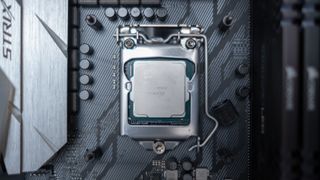Intel says Ice Lake is on target, and even faster 7nm CPUs will arrive by 2021
Chip giant has learned from the difficulties in getting Ice Lake right

Intel has clarified that its long-delayed next-gen processors built on a 10nm process will start to ship in June, and indeed that the chip giant has learned from its mistakes, and will be able to push forward with greater speed dropping to 7nm CPUs promising even better performance come 2021.
This, and a ton of other roadmap and product info, was divulged by Intel at its 2019 investor meeting.
Intel claimed its 7nm products will debut in 2021 starting with Intel Xe, the next-gen graphics solution we’ve been hearing so much about lately, although in this case, the first offering will be a General-Purpose GPU for heavyweight usage in the data center. That will be followed by a 7nm Xeon (server processor).
- Intel's Project Athena aims for more efficient laptops
- Intel's new drive may do for SSDs what flash memory did for HDDs
- AMD vs Intel: which processors are better?
A consumer-targeted Intel Xe graphics card is expected in 2020, the year before the aforementioned GP-GPU, although that won’t be 7nm – but rather 10nm.
Speaking of 10nm, as we said at the outset, the first Ice Lake offerings will start shipping in June, and Intel’s 10nm ramp predicts that client systems will be on sale for the holiday season at the end of 2019. This is in line with what we’ve previously heard, namely that consumer laptops using Ice Lake processors will be available at the very end of the year. Server offerings using the CPUs will follow in the first half of 2020.
Furthermore, 10nm Tiger Lake processors will follow Ice Lake in 2020, arriving in laptops and packing Intel’s Xe graphics (rather than Ice Lake’s Gen11 integrated graphics), which will be capable of running multiple 4K displays (or driving an 8K monitor).
Pedal to the silicon
As Tom’s Hardware reports, chief executive Bob Swan noted that this forecasted swift move from 10nm to 7nm reflects an acceleration of the production of the process node.
Get the best Black Friday deals direct to your inbox, plus news, reviews, and more.
Sign up to be the first to know about unmissable Black Friday deals on top tech, plus get all your favorite TechRadar content.
In other words, Intel has learned a lot of lessons from the difficulties in transitioning from current 14nm chips to these incoming 10nm efforts, with the insights and gains therein meaning swifter progress when dropping down to 7nm (and subsequently refining). Or at least that’s the theory.
Intel further noted that Ice Lake (10nm) will effectively double integrated graphics performance levels compared to Coffee Lake CPUs – not surprising as it sports the aforementioned Gen11 graphics we’ve been hearing good things about – as well as doubling video encoding performance, and tripling wireless speeds.
As for 7nm performance, Intel is quoting impressive further steps on from there with gains in power and efficiency, specifically a 15% improvement in transistor performance, and a bigger 20% boost in terms of performance-per-watt.
Finally, it’s worth noting that Intel said that issues with stock shortages of current 14nm processors would continue to improve going forward, and that they would be fully resolved by the fourth quarter. The last we heard, this was expected to happen in the third quarter, but at any rate, Intel anticipates that inventory shortages will be a thing of the past before 2019 is out.
That’s good news certainly, as consumers and PC makers alike have been struggling when it comes to getting hold of Intel’s mid-range and particularly lower-end processors (as the chip giant has been concentrating on making high-end products with more profit margin using its limited production capacity).
- We’ve picked out the best laptops of 2019
Darren is a freelancer writing news and features for TechRadar (and occasionally T3) across a broad range of computing topics including CPUs, GPUs, various other hardware, VPNs, antivirus and more. He has written about tech for the best part of three decades, and writes books in his spare time (his debut novel - 'I Know What You Did Last Supper' - was published by Hachette UK in 2013).
Most Popular





